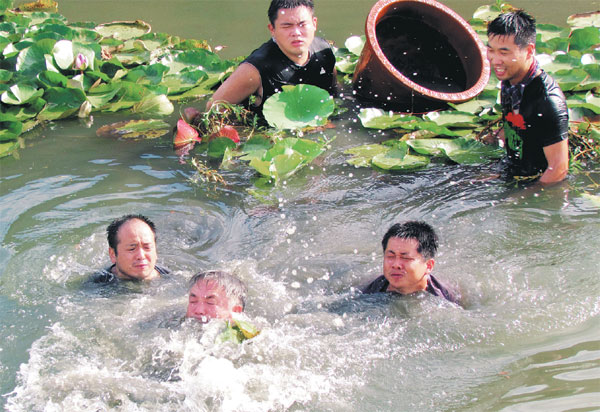
Yu Dan (middle) and student researchers attempt to plant aquatic seedlings in the bed of Liangzi Lake. (Photo provided to China Daily)
While China prepares to celebrate the Lunar New Year, one scientist has sacrificed the chance to be with family and friends so he can continue with his life's work.
With Spring Festival just days away, millions of Chinese people are making the long trek home for the most-important family reunion of the year.
However, Yu Dan won't be among them. Instead, Yu, a professor at the College of Life Sciences at Wuhan University, will remain at his research base on an island in the middle of Liangzi Lake, the second-largest freshwater body in Hubei province.
Even though the journey from the pier to the shore only takes about 10 minutes by speedboat, Yu rarely leaves the island, spending about 300 days there every year.
While the nation is enjoying the biggest family festival of the year, Yu won't even see his son, a doctoral student in nearby Wuhan, the provincial capital. Rather, he will continue the painstaking research that has dominated his life for more than 20 years, and has provided potential solutions to help restore damaged freshwater ecosystems.
Yu's strategy, which addresses a range of environmental problems, involves planting aquatic seedlings underwater to halt and even reverse environmental degradation. Aquatic plants absorb nutrients, such as nitrogen and phosphorus, which deprive blue-green algae of food, thereby improving the quality of the lake's water.
Once, Liangzi Lake, in central China, was a paradise for migrating birds. Situated on the south bank of the middle reaches of the Yangtze River, it is an ideal resting place for birds in winter, and is also a key provider of fresh water for the surrounding communities, where it is used for drinking and agriculture.
But, in common with many other bodies of water in China, the lake's complexion changed, and what was once a haven of aquatic plant life was, until recently, clogged with blue-green algae that reduced the level of oxygen in the water and resulted in the deaths of aquatic animals and plants.
In the 1980s and '90s, the annual summer outbreaks of blue-green algae began to occur more frequently after fishermen started using explosives and toxins to kill fish, and aquatic farmers poured chemicals into the water to prevent diseases that affect aquatic life.
The moves led to severe eutrophication, a form of water pollution caused by large quantities of external nutrients entering the water, helping the algae to grow more quickly.
The outbreaks not only produce dangerous toxins and raise the costs of treating the water to make it suitable for human consumption, but also create dead zones where the absence of oxygen kills fish and aquatic plants.
By the early 1990s, the lake's ecosystem had almost been destroyed. "It was no longer a good place for birds to stay," Yu said. "Because the lake is located within the densely populated city of Wuhan, every step toward restoring the eco-balance has been difficult."
Wang Chao, vice-chancellor of Hohai University, a research institute in Nanjing, Jiangsu province, said the problem isn't confined to Liangzi Lake: "Algal blooms are a major source of pollution in the lakes along the Yangtze River, and about 69 percent of them are in a state of eutrophication."


















































